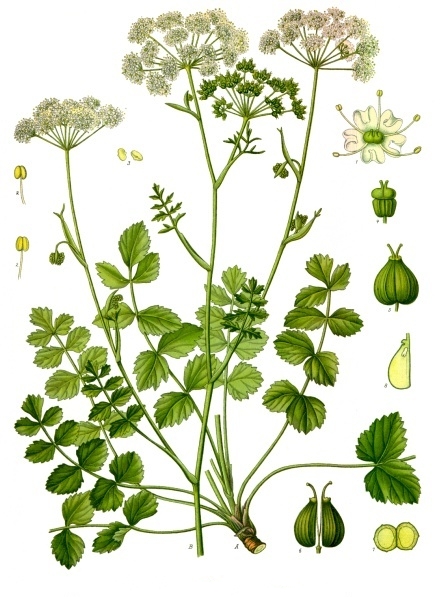Dies ist eine alte Version des Dokuments!
Pimpinella saxifraga L. - syn.Pimpinella nigra Mill.; Pimpinella alpestris Spreng. - Apiaceae
burnet saxifrage, small burnet, lesser burnet, Kleine Bibernelle
Perennial herb, 0.30-0.60m high, native to Europe, West Asia, naturalized in North America; stem round in cross-section; leaves pinnate; flowers pink.
„Pimpinella saxifraga subsp. eusaxifraga: Because of the wide range of morphological variability and the unsatisfactory systematic division it seemed necessary to investigate the essential root oils from plants with simple segmented leaves and dissected leaves separately. Main constituent (about 60%) of the root oils from both forms is trans-epoxy-pseudoisoeugenyl-2-methylbutyrate. Furthermore, it is characteristic for these two oils that 1,4-dimethyl-azulene and its postulated precursors are only present in relatively low concentrations (totally about 5%). In a very few cases we could not at all establish the occurrence of 1,4-dimethylazulene in the volatile oils of roots from Pimpinella saxifraga subsp.eusaxifraga. Interestingly, the root oils of plants with simple segmented and dissected leaves also exhibit significant differences, mainly in the sesquiterpenes.
The root oil obtained from plants with simple segmented leaves contains 7.5% of an unknown sesquiterpene hydrocarbon C15H22, besides germacrene-B (2.7%) and germacrone. The latter can be recognized by a broad peak in the gas chromatogram, due to cope-rearrangement, representing 17.2% together with its rearrangement product ß-elemenone. In contrast, these three compounds usually do not occur, or could only be detected in traces, in the root oil from plants with a dissected leaf-form. The major sesquiterpene in this oil is trans-ß-farnesene (10.9%).
Pimpinella saxifraga subsp. alpestris: This subspecies comprises small plants, growing in mountainous regions and cannot be distinguished reliably from special forms of the subsp.eusaxifraga by morphological features.
The essential root oil of Pimpinella saxifraga subsp.alpestris is dominated by the C12-hydrocarbons pregeijerene and its thermal rearrangement product geijerene (together amounting to 31.5%). The phenylpropanoid
trans-epoxy-pseudoisoeugenyl-2-methylbutyrate shows a lower proportion (23.9%) in comparison with the subsp.
eusaxifraga. Besides this, the large amount of ß-bisabolene (17.5%), being distinctively higher than
in the other root oils, seems remarkable. As already observed in case of the root oils of the other Pimpinella subspecies (Table I) monoterpene hydrocarbons can only be detected in traces.
Pimpinella saxifraga subsp. nigra: This subspecies can be delimited from the others chiefly by cutting the fresh root from which a blue oil emerges, indicating the formation of an azulene derivative (1,4-dimethylazulene)… It is noteworthy that in contrast to the previously mentioned oils, the root oils of
Pimpinella saxifraga subsp.nigra are dominated by different C12-compounds, which represent approximately 60% and 80%, respectively, of these oils. Pregeijerene, 1,5-dimethyltricyclo-(4.4.0.02‘6)deca-4,7-diene and an unknown constituent are supposed to be intermediates, arising by stepwise dehydrogenation and cyclization during the formation of 1,4-dimethylazulene. The latter component, which was described in Pimpinella saxifraga
subsp.nigra for the first time by Meuche and Huneck, is responsible for the characteristic blue colour of
the root oil of this plant. It is remarkable that this norsesquiterpene is not a distillation artefact in the
root oil of this plant. This is worth mentioning, because in the volatile oils of Thapsia garganica L. and
Ruta graveolens L. 1,4-dimethylazulene is a decomposition product formed during hydrodistillation.“
[The compositions of the essential root oils from Pimpinella saxifraga sl and chemotaxonomic implications., Kubeczka, K. H., Bohn, I., Schultze, W., Z. Naturforsch., 44c, 1989, 177—182] http://zfn.mpdl.mpg.de/data/Reihe_C/44/ZNC-1989-44c-0177.pdf

Pimpinella saxifraga L. var. dissectifolia; Kohl, F.G., Die officinellen Pflanzen der Pharmacopoea Germanica, t. 77 (1891-1895)

